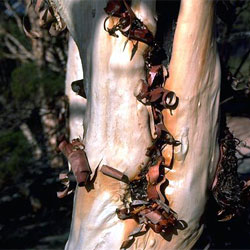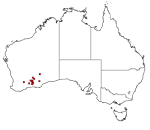Melaleuca exuvia
 |
 |
Melaleuca exuvia Craven & Lepschi
The plants most distinguishing feature is undoubtedly the very striking pinkish-fawn bark that becomes exposed when the outer layer flakes and curls off in thin strips. The white sand backdrop in the area makes this a very characteristic feature of the landscape. The attractive habit is generally a shrub to 6m and quite often multiple stemmed. The leaves are green, alternate and linear to oblong, 7-30mm in length and 0.6-1.3mm wide, making up a crown to 9m wide. Between mid November to mid December small globular heads of showy yellow flowers form. The fruits are small, woody capsules which can be retained for years.
 M.
exuvia has a small distribution, restricted to the Norseman and Esperance
districts of southwestern Western Australia. Growing along semi-saline ephemeral
drainage lines, it is prominent along the Lort River, Johnson Lakes and Lake
King area. The salt tolerance of the plant is unknown since no cultivation trials
have yet been conducted but it does give a saline tolerant impression.
M.
exuvia has a small distribution, restricted to the Norseman and Esperance
districts of southwestern Western Australia. Growing along semi-saline ephemeral
drainage lines, it is prominent along the Lort River, Johnson Lakes and Lake
King area. The salt tolerance of the plant is unknown since no cultivation trials
have yet been conducted but it does give a saline tolerant impression.
Although M. exuvia is unknown to cultivation, melaleucas in general, adapt to a wide range of conditions, tolerating light frosts and flowering profusely when in full sun but also succeeding in dappled shade. They are useful trees for street, park and garden planting and are useful as windbreaks and for draining areas prone to excess water but will also withstand dry conditions. The flower nectar attracts birds and small animals and they are remarkably free from pests and disease. Webbing caterpillars can become a nuisance and should be treated early before the plant becomes established. Once established only occasional watering will bring rewards.
Maintenance may include, pruning, fertilizing and raking up of shed bark. Light pruning is recommended after flowering, as the new growth comes from the tip of the flowering spike well before flowering is complete. However, with sturdy plants the loss of new growth is not important and it is wise to prune fairly hard to obtain a shapely bush. Melaleucas only need light fertilising with a well balanced, slow release native plant fertilizer. The lower branches may also be removed to accentuate the bark characteristics.
Most melaleucas propagate readily from seed and tip cuttings taken just as the current season’s growth begins. Seeds retain viability for a long period and don’t need pretreatment. Germination percentage is usually high if seed is sown thinly and is not overcrowded (normally there is 1400-5000 seeds/g). Semi-hardwood cuttings have shown to give good results with most species.
It is quite possible that these shrubs have specific soil requirements that may need to be imitated in cultivation. It is also unconfirmed as to whether they are as adaptable as other melaleucas and if the roots are in the saline layer or are deep rooted into less acidic soil. Expected cultivated growth rate and form, including height, is unknown. Overall though, the bark of these shrubs would make a spectacular garden feature and would bring many rewarding years.
Text by Leilani Weier (Botanical Intern 2003)
Derivation of botanical name: Melaleuca exuviaLinnaeus established the genus Melaleuca, a member of the family Myrtaceae, in 1767, the Greek derivation for melas meaning black and leucon, white, referring to the contrasting colours after a fire of the black trunk and white branches. Melaleuca exuvia is currently (2003) an unpublished name as the species has only recently been recognized as new. It had formerly been included in the M. uncinata (Broombush) complex. The name ‘exuvia’ is Latin and means ‘to slough
off’ (say ‘sluf’ meaning to shed or cast off). |
References
Craven, L. (2000). The Genus Melaleuca. Cited in: Association of Societies for Growing Australian Plants. Melaleuca and Allied Study Group. Newsletter No. 19
Lullfitz, G. (1978). Grow the west’s best native plants. Panorama Books. Perth.
Page, R. (1998). Melaleuca – the forgotten bottlebrush. Cited in: Association of Societies for Growing Australian Plants. Melaleuca and Allied Study Group. Newsletter No.15.
Spencer, R. Turzac, P. Barley, A. Pearson, S. (1995). Horticultural flora of south-eastern Australia: the identification of garden and cultivated plants. University of New South Wales Press. Sydney.
All other information in the publication has gratefully come from Brendan Lepschi and Peter White whom, with their colleagues studied M. exuvia and found it to be taxonomically different to M. uncinata.
![An Australian Government Initiative [logo]](/images/austgovt_brown_90px.gif)

